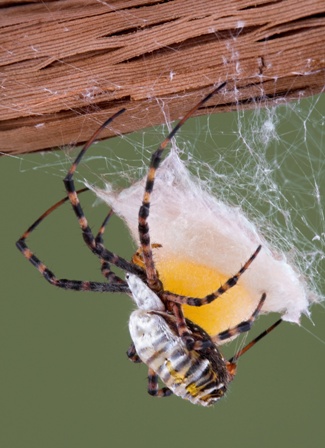- Series:Animals, Transcript English
Romans 11:33
“O the depth of the riches both of the wisdom and knowledge of God! how unsearchable [are] his judgments, and his ways past finding out!”
Spider silk begins as a liquid protein made by silk glands on the spider’s abdomen. Spiders make many kinds of silk for different uses. As the liquid silk is forced through the spider’s spinnerets, it begins to dry. The spinnerets pull and stretch the silk, creating just the right kind of silk for the spider’s use. Though the result seems thin and weak to us, ounce for ounce, spider silk is stronger than steel.
 Web-building spiders make two types of silk for their traps. The basic structure of the web is made of strong, non-sticky silk. Then the spider adds a sticky, elastic silk to trap its prey. Some webs are irregular, others are flat and sheet-like, while still others are shaped like funnels. All of us have admired the beautiful orb web.
Web-building spiders make two types of silk for their traps. The basic structure of the web is made of strong, non-sticky silk. Then the spider adds a sticky, elastic silk to trap its prey. Some webs are irregular, others are flat and sheet-like, while still others are shaped like funnels. All of us have admired the beautiful orb web.
However, spiders also have many other ways in which they use their silk. The ogre-faced spider makes a net that it throws around its intended victim. The European water spider builds its web underwater. It stores its air supply in the web. The lasso spider twirls a single strand of silk over its head. A tiny drop of sticky silk at the end of the lasso captures its prey when the lasso is thrown. Probably the most creative use of silk is by the young of some species. When they hatch, they produce long loops of silk that catch the wind and send them floating off to new places.
The spider’s skill in producing and using silk had to come from Someone wiser and more clever than the spider. Clearly, the spider has been well-equipped and instructed by its Creator.
Prayer:
Father, I thank you for the intelligence and wisdom You have so freely given to Your creatures. Help me to treasure, most of all, Your wisdom in the work of Jesus Christ for my salvation so that my life, too, may glorify You. In Jesus’ Name. Amen.
Notes:
Pinkston, William S., Jr. 1980. BIOLOGY for Christian Schools. Greenville, SC: Bob Jones University Press. p. 413.
